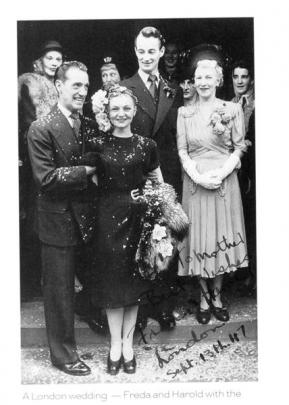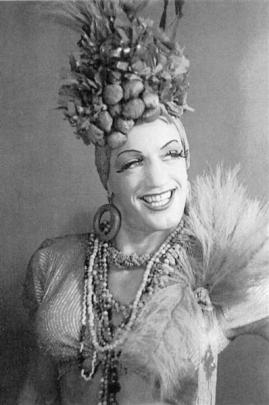He danced from the back streets of South Dunedin, through the Depression, and all the way to Covent Garden. And he gleefully courted controversy most of the way. Nigel Benson meets Harold Robinson.
Harold Robinson moves slowly these days. But his eyes still dance.
And he wears a satisfied smile, after what has been a most extraordinary life.
The 89-year-old ("I'm 90 in January," he beams, with all the enthusiasm of a 9-year-old about to turn 10) returned to Dunedin last weekend for only the second time since he left during World War 2.
Robinson grew up at 18 Richardson St, South Dunedin, later attending St Clair School and King Edward Technical College.
It was a tough time to be growing up, as the optimism of the 1920s gave way to the Depression of the '30s, and even tougher for a South Dunedin boy who was passionate about "fancy dancing", as ballet was disparagingly known.
Robinson's theatrical talent was encouraged by his mother from an early age and as a 10-year-old boy soprano he was selected to tour Australia with the Westminster Glee Singers.
He was also an enthusiastic member of the Dunedin Shakespeare Club, Otago Repertory Company and Lily Steven's dance studio in Rattray St.
In 1939, when he was 19, the prestigious Ballet Russe de Monte Carlo visited Dunedin and Robinson's talent caught the eye of male lead Anton Dolin.
"But, in those days, in spite of my theatrical activities, I was inspired to take holy orders," he says.
"I was drenched in holy blood. But they were very strait-laced, the Church of England," he says, smiling.
Robinson would regularly ride a bicycle to Seacliff to take Sunday school there.
"I still have my lay reader's licence."
All such considerations were put to one side when he was called up to the army in 1941.
The next four years were spent serving with the 36th Battalion in the Pacific and the 3rd Division in Egypt.
For some time he served as batman to Sir John Marshall, who later became prime minister of New Zealand.
"He was the soul of rectitude and correct Presbyterian standards," Robinson recalls.
"I remember him saying once to me: 'There is no wine like a glass of cold water' and I thought 'To hell with that', but I didn't contradict him because that would have been rude."
The pair had a close friendship for an officer and batman.
"He called me Robbie and I called him Marshie, but there was never any over-familiarity in the address."
Robinson performed in the New Zealand Army Concert party where his star turn was to dress up as Carmen Miranda.
"The troops loved the numbers where we were all dressed in drag. I did a Carmen Miranda item, with my costume made from dish cloths dipped in aluminium by the American boys at the aerodrome, and silver paper to look like silver lamé."
Robinson was once called a "pansy" by another soldier. He promptly flattened his detractor.
He never had any problems again.
On his return to New Zealand, Robinson applied for a Returned Servicemen's Bursary to study ballet in London.
"I was well into my 20s after four years in the army, whereas now a young man in the Royal Ballet would be dancing at 5 years of age and by 15 would be a superb classical dancer."
The story of a New Zealand soldier wanting to study ballet caused outrage in conservative New Zealand.
Robinson stoically ignored the criticism and became the first New Zealander to be accepted by the Sadlers Wells Ballet (now Royal Ballet), in London, where ballet immortals Dame Margot Fonteyn and Robert Helpmann were the company principals.
"Male dancers were very scarce in London at the time. I just happened to be in the right place at the right time," he says modestly.
"I had a great theatrical ability, but I wouldn't say I was ever a great dancer."
While in London, Robinson would meet someone who would forever change his life.
Freda Stark, a confirmed lesbian who stood just 1.4m tall, was known as "The Fever of the Fleet" after dancing in nothing but a feather headdress, a g-string and a coat of gold paint in the Auckland Civic Theatre for American sailors during World War 2.
Stark's notoriety did not end there.
In 1936, she had been the star prosecution witness in a high-profile murder case that captured the country's imagination like a New Zealand version of Chicago.
Stark had befriended Australian composer Eric Mareo (45) and his younger wife, Thelma Trott (28) and the two women soon became lovers.
But on Sunday, April 15, 1935, Trott fell into a mysterious deep coma and died in Auckland Hospital.
Five months later, Mareo was arrested and charged with murdering his wife by giving her a barbituate called Veranol, in a cup of hot milk.
Justice Fair put on a black cap and sentenced Mareo to be hanged by the neck until dead.
The death sentence was later commuted to life imprisonment under the policy of the new Labour Government.
Mareo was eventually released from prison on May 11, 1948, whereupon he immediately changed his name to Eric Curtis.
Curtis died on November 25, 1960.
Trott was buried in a Waikumete cemetery in Auckland under a tomb inscribed: "Waiting til we meet again ... Freda."
When Stark died more than 60 years later, Robinson arranged for her ashes to be placed inside her old love's grave.
Robinson met Stark in London in 1941, when he arrived at the party of a mutual friend, in his khaki army uniform.
"I will never forget walking in and there was Freda Stark sitting across the room," he recalls.
"Her eyes twinkled at me in that saucy way she had ... she looked absolutely wonderful."
To the surprise of many of their friends, the pair married on September 13, 1947.
"He was 22 and gay and she was 31 and a lesbian. Rather to his astonishment, Harold found he was greatly attracted to her," Stark's niece Diane Miller said in the biography Freda Stark - An Extraordinary Life.
"We'd been friends for a very long time," Robinson says.
"Freda was a lesbian at heart, but she'd also had several older male lovers. I was very proud to be her first young male lover."
In 1946, the pair achieved further notoriety when they appeared in a film by Auckland photographer and film-maker Robert Steele, Curves and Contrasts.
The five-minute film was considered lost for many years, but was rediscovered in 1995 in a private collection on the West Coast and is now in the New Zealand Film Archive.
Robinson and Stark married at Primrose Hill on September 13, 1947, at the church of St Mary-the-Virgin.
The name of the church reportedly caused their friends much merriment.
In 1948, after dancing in a summer season at Covent Garden with the Vienna State Ballet, Robinson joined the International Ballet company.
Despite his success, he was happy for Stark to be the star.
"That was how it was all my life, I just became Mr Freda Stark. I was very proud," he says.
"I'm so excited to have lived through such a fabulous time."
Among the hallmarks of that "fabulous time" was the fashionable status homosexuality enjoyed in Oxford and Cambridge University circles, where homosexuals were regarded as bon viveurs, with sophisticated taste and a knowledge of the arts.
In 1952, Robinson joined the risque Windmill Theatre in London's seedy Soho district, where he was understudy to Bruce Forsyth, of game show fame.
"The ladies were always beautifully dressed, but they wore nothing underneath. It was rather notorious, really."
In 1953, Robinson and Stark sailed back to New Zealand on the Akaroa.
Robinson established a new career teaching dance and opened a gown shop, The Bridal Boutique, in Queen St, Auckland.
Robinson and Stark divorced in 1973, but remained close friends until she died on March 19, 1999.
Six months after her death, the Civic Theatre renamed its cocktail bar "Stark's" in honour of the Fever of the Fleet.
Robinson maintains close ties with Dunedin through friends such as artist-jeweller John Z. Robinson and milliner Lindsay Kennett.
"John sends me a letter every Saturday morning and I have many of his paintings in my living room in Auckland."
A large ring designed by the Dunedin jeweller flashes whenever Robinson throws his hands around, which is often.
"Dunedin will always be my home. It's my home town. I think it's the most beautiful city in the world," he says.
"I feel terribly proud that I was able to grasp my opportunities after I'd spent all my youthful, impressionable time in Dunedin. I love the place.
"My heart is in Dunedin. You might think I'm a silly old-fashioned boy, but it's a remarkable city and I love it very, very much."
Robinson's parents are buried in the Andersons Bay cemetery.
"I'm hoping to have my ashes buried there, too," he muses.
"Or maybe scattered at Lawyers Head. Because, as a boy, I spent a lot of time racing around St Kilda Beach and I can look down over the flat over Musselburgh and St Kilda and St Clair and see that wonderful long stretch of beach . . ."
















